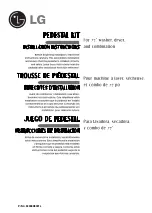
16
8. MAINTENANCE AND CLEANING
•
Before cleaning, unplug the fryer and
wait for it to cool.
•
Remove the basket and disassemble the
handle
(Fig. 5)
•
Disassemble the control panel and if
necessary, clean with a damp cloth. Do
not submerge in water.
•
Remove the pan from its housing
(Fig.
6)
and empty before cleaning. To remove
used oil or liquid fat, pour the contents
of the pan into the original recipient. If
you have used solid fat, wait for it to
solidify and then empty the pan using a
spatula.
•
Clean the lid, the basket and handle,
the pan and the outer housing in warm
soapy water. Rinse thoroughly and
dry well. These elements can also be
washed in the dishwasher.
•
Do not use solvents, abrasive detergents
or metal scourers to clean the fryer.
•
Place the power cable into its housing
and reassemble the fryer in the following
order:
- Pan
- Control panel + element
- Basket with mounted handle
- Lid
•
Store the fryer with the lid on to keep the
inside clean and free from dust.
9. PRACTICAL ADVICE
indicates that the oil/fat has reached
the selected temperature. The pilot light
(9)
will continue to switch on and off
in keeping with the thermostat cycles
throughout the entire cooking period.
If you wish to carry out a number of
continuous frying operations, wait until
the pilot light
(9)
has switched off before
placing the next item of food in the oil/fat.
•
MOD. 200/350:
When the pilot light
(12)
switches off (10-15 minutes), this
indicates that the oil/fat has reached
the selected temperature. The pilot light
(12)
will continue to switch on and off
in keeping with the thermostat cycles
throughout the entire cooking period.
If you wish to carry out a number of
continuous frying operations, wait until
the pilot light
(12)
has switched off
before placing the next item of food in
the oil/fat.
•
Place the basket with the food slowly
into the oil to prevent any water in the
food from causing the oil to bubble up
over the sides of the pan.
•
Keep a close eye on the whole frying
process.
After frying
•
Remove the basket from the pan, shake
a little and then hook into the draining
position
(Fig. 4)
. Place the food on a
tray over a piece of absorbent kitchen
paper. While you are doing this, the
oil will have time to reach the right
temperature for the next frying operation
(the pilot light will switch off once again).
•
Use a strainer to remove any loose
particles of fried food that may have
come off the main pieces and are
floating in the oil. Leaving them to toast
will have a negative effect on the quality
of the oil.
•
When you have finished frying, turn the
thermostat switch to the ‘0’ position,
switch off the appliance and unplug the
appliance from the mains. If the fryer
is used often, submerge the basket in
the oil and place the lid over the top for
protection.
•
Wait for the oil to cool completely before
disassembling and cleaning the fryer.
•
If you are not going to use the fryer for
a while, we recommend that you store
the oil or liquid fat in airtight recipients,
either in the fridge or in a cool place. Fill
the recipients by straining the oil or liquid
fat through a fine sieve to eliminate any
left-over particles of food.
•
If you have used solid fat, leave it to
solidify in the pan and then store the
fryer with the fat still in it. (See ‘Using
with solid fat’).
Oils and fats
•
Always use oils/fats appropriate
for frying at a high temperature. In
















































